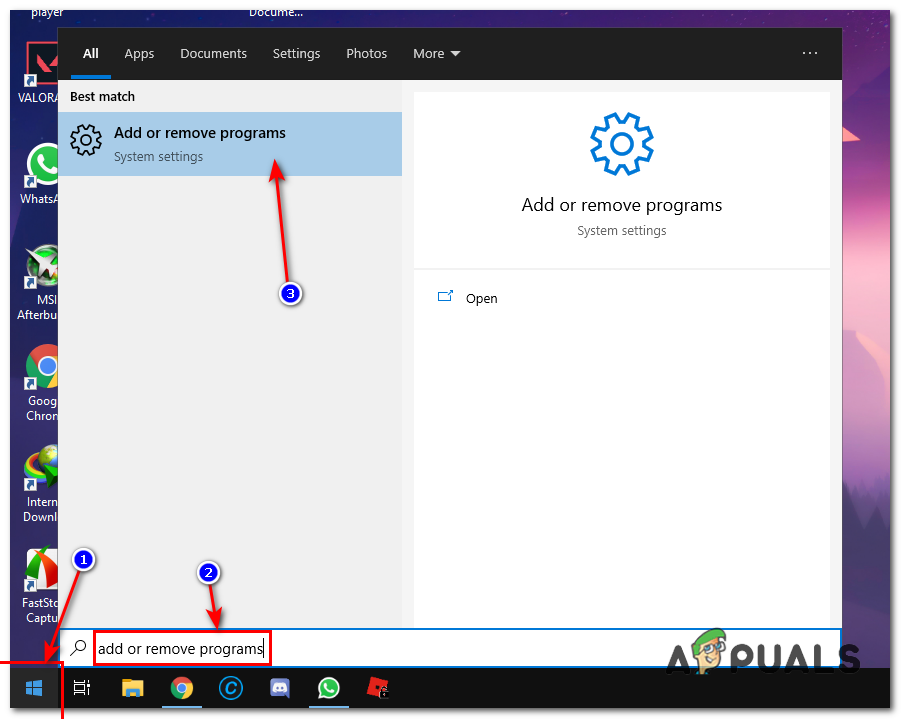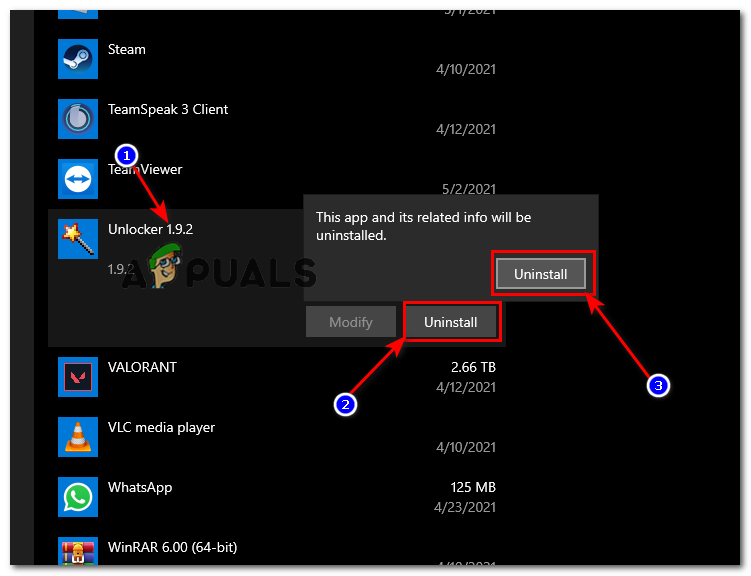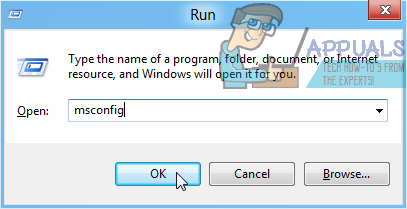How To Remove Built In Windows 10 Apps
Windows 10 allows you to uninstall the programs, and there are various methods available for you to uninstall a program. Uninstalling a third-party application or program on Windows 10, the latest and greatest in the long line of Windows Operating Systems is pretty easy. If you simply don't know how to uninstall a program, here is the most common and simplest method that you can try in order to uninstall the program. Follow these steps below:-
- Click on the Start Menu, located on the left corner of your Windows.
- Search for "Add or remove programs"then click on the settings page.

Searching for the uninstaller - Find the program you are trying to uninstall, click on it once and click "Uninstall".

Uninstalling the program - Go through the uninstallation utility by following the onscreen instructions, and the program will be uninstalled.
- Wait for the program to uninstall successfully.
If you are not using Windows 10, but you are using an older version of Windows, you can try to open the older uninstalling utility. Follow these steps:
- Press and hold the Windows key on your keyboard then press "R", this should open Run.
- Now type "appwiz.cpl" then press enter.

Opening add or remove programs - This should open the old Windows uninstalling utility.
- Now simply find the program you are trying to uninstall, right-click on it, and then click "Uninstall".

Uninstalling the program - Follow the onscreen instructions as usual.
- Check to see if the program is uninstalled.
However, unfortunately for Windows 10 users, sometimes the Operating System fails to uninstall certain third-party programs. When a Windows 10 user fails to uninstall an application they themselves installed on their computer, they can end up being taken aback (understandably so) and wondering what they should do next.
Well, thankfully for Windows 10 users, failing to uninstall a third-party program or application through theAdd or remove programsutility and theSettingsapp is not the end of the line – there are a wide variety of different methods that can be used to uninstall programs on Windows 10 that could not be uninstalled using conventional means. While there are a lot of different methods that you can use to try and uninstall a program on a Windows 10 computer that could not be uninstalled using theAdd or remove programsutility and theSettingsapp, the following are the absolute most effective ones:
Method 1: Use the uninstaller that came with the application
If the program you are trying to uninstall doesn't exist in the uninstallers, it's possible that the registry file of that program is removed. Fortunately, Most (not all) third-party programs and applications come with their very own uninstaller. This is an executable utility located in their root folder that is basically an uninstallation wizard – this utility can be used to uninstall the program it belongs to from the computer it is installed on. To use this method, simply:
- Navigate to the directory on your computer where the program or application in question is installed.For example:- the default directory for most third-party programs is X:\Program Files \(Name of application)orX:\Program Files (x86) \(Name of application),X in both directories being the letter corresponding to the partition of your computer's hard drive that Windows 10 is installed on.
- Look through the contents of the directory for an executable uninstallation utility. This utility is usually nameduninstaller.exeoruninstall.exe(or something similar).
- Once you have located the executable uninstallation utility, double-click on it to launch it.
- Follow the onscreen instructions all the way to the end of the uninstallation wizard, at which point the wizard will uninstall the program that you were unable to uninstall using conventional methods.

Uninstalling Procedure
Method 2: Remove the program from your computer using the Registry Editor
Every third-party program or application you install on your computer develops a significant presence in your computer'sRegistry. If you delete all traces of an application from your computer'sRegistry, you basically remove it from your computer, effectively uninstalling it. If you're having trouble uninstalling an application via the usual methods, you can simply remove the target program from your computer using theRegistry Editor. To do so, you need to:
- Press theWindows Logokey +R to open aRundialog.

- Typeregeditinto theRundialog and pressEnter to launch theRegistry Editor.

- In the left pane of theRegistry Editor, navigate to the following directory:
HKEY_LOCAL_MACHINE >SOFTWARE >Microsoft>Windows>CurrentVersion >Uninstall. - In the left pane of theRegistry Editor, locate the sub-key pertaining to the program or application you want touninstallfrom your computer under theUninstallkey.
- Once you have located the sub-key belonging to the program or application you want touninstall (it might not have the exact same name as the target application), right-click on it and click onDeletein the resulting context menu.
- Click onYesin the resulting popup to confirm the action.
- Once the sub-key belonging to the target application has been successfully deleted, close theRegistry Editorandrestartyour computer.
When the computer boots up, check to see whether or not the target application has been successfully removed from your computer.
Method 3: Uninstall the target application with your computer in Safe Mode
If you are having trouble uninstalling an application on Windows 10, the cause of your troubles might be some third-party interference. The best way to get rid of any and all kinds of interference on a Windows computer is to boot it into Safe Mode. While in Safe Mode, the only things allowed to run on a Windows computer are stock applications and services – even internet access and theCommand Promptand disabled in some versions of Safe Mode. You might just be able to uninstall an application you otherwise couldn't using conventional methods while your computer is in Safe Mode. If you would like to use this method, you need to:
- Press theWindows Logokey +R to open aRundialog.

- Typemsconfiginto theRundialog and pressEnter to launch theSystem Configurationutility.

- Navigate to theBoottab of theSystem Configurationutility.

- EnabletheSafe bootoption under theBoot optionssection by checking the checkbox located directly beside it.

- Click onApplyand then onOK.
- Click onRestartin the dialog box that pops up to immediatelyrestartyour computer.
When the computer boots up, it will be in Safe Mode. While the computer is in Safe Mode, use either set of steps listed and described at the very beginning of this guide to try and uninstall the target application from your computer and check to see if the uninstallation succeeds.
Method 4: Use a third-party uninstallation program to uninstall the target application
If all else fails and none of the methods listed and described above work for you, you can still try to uninstall the target application using a third-party uninstallation program. There are a multitude of different third-party programs for Windows 10 that are designed specifically to make it not only possible but also easier for users to uninstall applications, andRevo Uninstallerhappens to be one of the very best ones. To uninstall the target application usingRevo Uninstaller, you need to:
- Make sure the application you want to uninstallis not running in any capacity (pressingCtrl+Shift+Esc to bring up theTask Manager, locating and right-clicking on the process belonging to the target application in theProcessestab and clicking onEnd taskin the resulting context menu should get the job done).

- Gohereand click on Free Downloadto download the installer forRevo Uninstaller.
- Once the installer for the program has been downloaded, navigate to where you saved it, locate it and double-click on it to run it.
- Follow the onscreen instructions and go through the installer until the program has been successfully installed.
- LaunchRevo Uninstaller.
- WhenRevo Uninstalleropens up, it will be displaying all of the third-party applications installed on your computer. Locate the application you want to uninstall from your computer in this list and double-click on it.
- Click onYesin the resulting dialog box to confirm that you indeed want to uninstall the target application.
- In the dialog box that opens up,Revo Uninstallerwill provide you with four differentUninstall Modesthat you can choose from.Built-inmode only uses the uninstaller the target application came with to try anduninstallit,Safemode has all ofBuilt-inmode's features combined with light scans of the computer's registry and hard drive for files and registry entries left behind by the target program,Moderatemode's combinesSafe modewith an extended scan for leftover files and registry entries, andAdvancedmode does everythingModeratemode does with the addition of a deep and thorough scan of theRegistryand hard drive for remnants left behind by the targe application. It is recommended that you selectAdvancedmode and click onNext.
- Wait forRevo Uninstallerto create a system restore point and make other arrangements, and once it is done, click onNext.
- Click onUninstall.
- Once the uninstallation process has been completed, click onCloseto close the uninstallation wizard.
WhenRevo Uninstalleris entirely done uninstalling the target application and removing all of its files and registry entries from your computer, you can close Revo Uninstaller,restartyour computerand, once it boots up, check to make sure that the target application has indeed been fully uninstalled.
![]()
Kevin is a dynamic and self-motivated information technology professional, with a Thorough knowledge of all facets pertaining to network infrastructure design, implementation and administration. Superior record of delivering simultaneous large-scale mission critical projects on time and under budget.
How To Remove Built In Windows 10 Apps
Source: https://appuals.com/how-to-uninstall-programs-on-windows-10-that-wont-uninstall/
Posted by: coxthared.blogspot.com

0 Response to "How To Remove Built In Windows 10 Apps"
Post a Comment